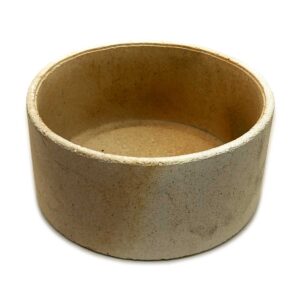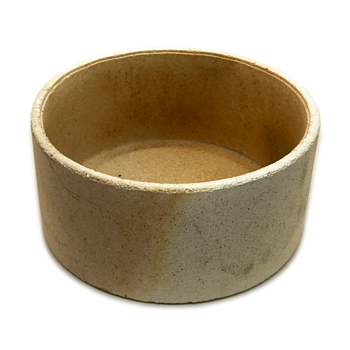
When firing ceramics, they are placed in a fireclay container and loaded into the kiln to protect them during firing. The container is commonly referred to as a pod. In the Owari and Mino (Aichi and Gifu prefectures) regions, it is called engoro.
Saggars are stacked in saggars and then stacked in the kiln. Saggars are made of refractory clay to withstand high firing temperatures, and the shape and size of the saggars are determined according to the shape and size of the items to be placed in them.
Superior items are not placed directly on the saggars, but are placed on a refractory stand. This is probably because the saggars should be able to withstand sufficient heat, but may still be slightly distorted by the load and heat. Since the method of kiln-filling greatly affects the capacity of a kiln and its economy, potters are constantly devising various methods of kiln-filling to achieve firing economy through the shape of the saggars and the way they are filled. Various methods are also used to prevent distortion depending on the shape and thickness of the base material. For example, thin-walled bowls are easily distorted when fired face up, so they are placed on a clay base (made of the same clay as the base), while bagged items are fired with a clay base made to fit the mouth to prevent distortion of the mouth only. Long, slender pieces are fired by hanging them on the top of a tsuri-yaki, or “fishing ware,” while other types of pottery are fired on a separate stand to prevent the glaze from running down and sticking to the bottom of the piece. When packing the pieces into saggars and placing them in the kiln, it is economical to make the space between the saggars narrower. However, if the space is too narrow, the fire will not circulate well and the heat will be uneven.
Saggars must be able to withstand heat, and at the same time, they must not shrink during firing and must be resistant to sudden changes in heat. If the saggars cannot withstand heat, the semi-molten base will be curved and will not retain its original shape. If the shrinkage is too great, there is a danger of collapse during firing. If the saggars are not resistant to sudden changes in heat, they will break during firing or when cooling after firing, damaging the contents. Therefore, the raw materials for saggars should be carefully selected to meet these conditions, and at the same time, the raw materials should be fired to a firing temperature higher than the working temperature to prevent shrinkage before use. This clay, once fired and crushed, is called chamotte (baked powder), which alone is not viscous and cannot be formed, so a minimum amount of clay is added as a bonding material. The size of the chamotte grains is also studied for resistance to sudden changes in heat. Saggars can be used as many times as necessary as long as they are not damaged, but their service life is short for high fire rates.
Broken saggars can be crushed again and remanufactured by adding a small amount of clay. With the recent development of the ceramics industry, a variety of new materials have been developed to meet the needs of the industry. Among them, cordierite-based materials are already in common use.



